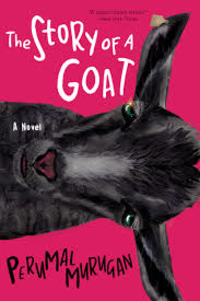
First published in India in 2018; published in translation by Grove Press/Black Cat on December 10, 2019
An anthropomorphized goat named Poonachi thinks human thoughts, or perhaps her goat thoughts happen to coincide with those that are common to humans. Her simple life as a goat opens a window on human behavior and attitudes. Poonachi experiences love and desire, loss and depression, jealousy and bitterness. She relishes freedom and resents limits that are placed on her behavior. As do many people who have little control over their simple lives, she bemoans her fate.
The story is set in an arid stretch of land called Odakkan Hill, presumably in or near the state of Tamil Nadu in India. An old man receives a black newborn goat as a gift from a tall stranger in a loincloth who predicts that the goat, as the last kid from a litter of seven, will give birth to seven kids of her own. The stranger is looking for a kind heart to raise the goat, knowing that “men of fortune are as plentiful as fruit worms, but a kind heart is rare.”
The old man’s wife names the malnourished kid Poonachi and raises her as if she were a daughter. The couple’s own daughter lives in another village. They see her only once a year when they travel to the daughter’s village for a festival.
The old man and his wife graze goats and grow a few crops, barely surviving from year to year but living serene lives. Poonachi’s life is equally difficult. Soon after the old man brings her home, Poonachi is nearly carried away by an eagle and is later threatened by a wildcat. She suffers a fever after her ear is pierced by a vindictive bureaucrat. When she is older, Poonachi becomes lost in the forest. Exhilarated by the richness of her new environment, however, she isn’t sure she wants to be found.
Poonachi earns a reputation as a miracle goat, particularly when she fulfills her destiny by giving birth to seven kids. But later, in a year of no rain when the couple faces starvation, they wonder whether she is a curse.
While the story creates sympathy for the kindly old man and his wife, the reader’s most tender feelings will be devoted to Poonachi. Mixing with other goats, Poonachi is bullied by an old buck and feels like an outsider. Still, she slowly makes friends and develops a sense of security, a knowledge of her place in the world. That changes when she is taken to visit the old couple’s daughter. The trip is frightening but it opens Poonachi to new experiences and gives her the opportunity to meet Poovan, a buck who kisses her gently and makes her tremble “at the slightest touch of his horn on her body.”
Poonachi feels despair when she must leave Poovan and again when she must leave the forest. Being bred against her will makes her hate the world. She cries when her kids are taken from her and sold. She sees other members of her herd killed for their meat or as a sacrifice to the gods. Eventually she wonders whether life is worth living if everything that matters is sure to be lost. Only her memories of her second encounter with Poovan, who “helped her learn the secrets of her own body,” sustain her.
The novel’s lessons about the joys and hardships of life come from Poonachi and the old couple, but the novel offers some collateral lessons, as well. Farmers and goatherders impart their wisdom in bromides like “only the egg-laying hen knows the pain of an inflamed asshole.” The novel imagines a ruling regime that is a bureaucratic nightmare, one in which government officials carefully regulate the purchase, sale, and registration of goats. People are encouraged to inform on their neighbors if they do not report the birth of a goat. “The regime had the power to turn its own people, at any moment, into adversaries, enemies and traitors.” In the presence of officials, people have “mouths only to keep shut, hands only to make obeisance, knees only to bend and kneel, backs only to bend, and bodies only to shrink before the authorities.”
I don’t recall when I last read a novel that was quite so charming. The story is sad but enriching. Writers often anthropomorphize animals to illuminate the human condition. I wonder if Perumal Murugan anthropomorphized goats to give them a voice. He may be inviting the reader to consider whether animals are like humans in fundamental ways. Why do we assume that goats do not love each other, do not suffer when we separate them from their lovers or offspring, do not feel abused by owners who dictate their limitations?
I live near some goats who, when I pass them, stare at me with utter malevolence — or so it seems to me. Perhaps this story explains their animosity. It certainly reminds us how simple people, and simple goats who think like people, experience love and pleasure while enduring pain and loss in the course of lives that, in the end, are never simple.
RECOMMENDED